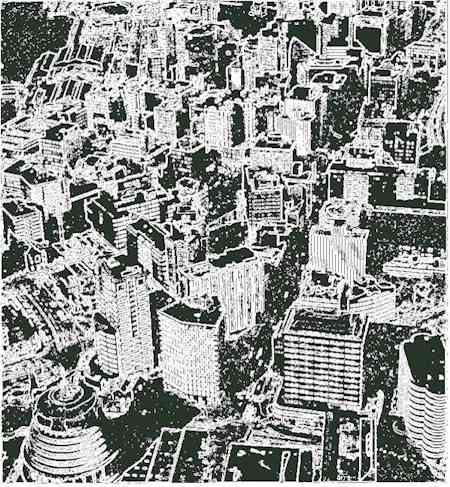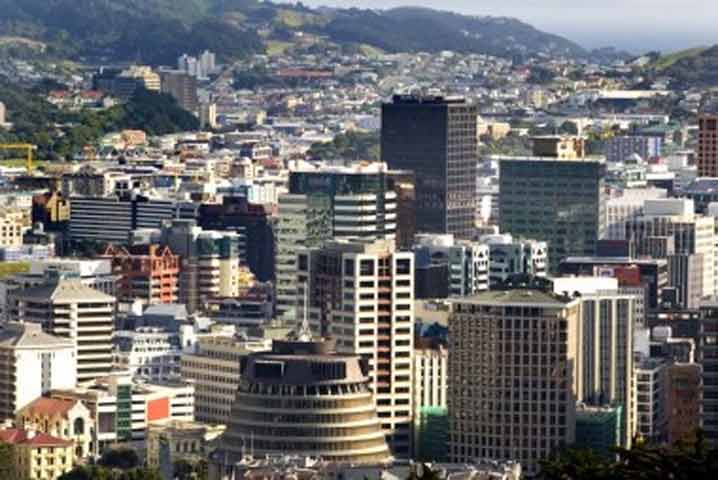Toughing It Out
Absolutely Positive (Mostly)I had an IQ test. The results came back negative. - Weird Wellington Happenings and Links
This is the negative from the previous page turned back positive again. Transitions cause a little detail to be lost but can make things much simpler. Now Wellington looks a bit like a colony of barnacles. The Beehive looks more like an inverted flowerpot.
Budget Economic and Fiscal Update Economic and Tax Outlook Summary[Excerpt] The central forecasts see annual average real GDP growth of 2.6% over the year to March 2008, up from 1.7% in the March 2007 year. The brief period of slower growth was not enough to lower inflation pressures which remain elevated and the exchange rate is at post-float highs. Despite an expected temporary easing in annual Consumers Price Index (CPI) inflation to 1.7% in September 2007, associated with volatile petrol prices and the high exchange rate, the domestic, non-tradables bias of growth means strong medium-term inflation pressures are forecast to persist. In response to more persistent inflation pressures, short-term interest rates are expected to be higher for longer than forecast. The upswing in growth is not expected to be sustained, allowing inflation to ease eventually
Eventually growth returns to trend and the pattern of growth becomes more balanced as interest rates and the exchange rate fall
In line with the Government’s fiscal strategy, [the government's] net worth is forecast to increase from $89.7 billion in 2006/07 to $112.4 billion by 2010/11. Source: treasury.govt.nz1, treasury.govt.nz2
Regional Labour Market Report - Wellington
Source: wellington.govt.nz Wellington City Council The New Zealand economy enjoyed relatively strong growth in late 2001 and early 2002, with economic output rising by 3.2% in the year to March 2002 compared to the previous year. Recent growth in the economy has been driven by the domestic sector, buoyed by high net immigration, low interest rates in 2001, high recent export earnings and a strong labour market. However, the world economic downturn resulted in weak export growth during 2001. The Wellington economy has not performed as well as the rest of the country over the past year. Latest activity indicators suggest that Wellington’s economy grew by a solid 2.7% in the year to March 2002, but this was the lowest growth of New Zealand's regions. Wellington's key sectors remain business, finance, insurance and property services, government administration and communication services, while sectors like manufacturing and retail trade are still important. The New Zealand labour market improved considerably during the year to March 2002, as employment rose strongly, the unemployment rate fell to a low 5.3%, and the labour force participation rate jumped to a very high 66.9%, the highest level in at least 16 years. The Wellington labour market was fairly steady in the year to March 2002 compared to the previous year: employment fell slightly, the unemployment rate dropped to 4.6% from 4.9%, and the labour force participation rate recorded a small rise to 69.6%. Also, the number of Unemployment Beneficiaries has been steadily falling in Wellington. The outlook for the New Zealand economy over the next year is for further solid growth of around 3%. Domestic demand is expected to continue driving activity over the rest of 2002, boosted by factors like high net immigration and robust consumer confidence, while a recovery in the world economy is forecast to lift the external sector in early 2003. As a result of this solid growth, labour market conditions are expected to remain strong during the next 12 months. The outlook for the Wellington economy over the next year is for a pick-up in growth, as the region is likely to benefit from continued growth in the domestic sector over 2002. Wellington firms are the most optimistic about the outlook for economic conditions over the next year, while consumers are also optimistic about the future, a positive for investment and consumption growth in the region. The Wellington labour market is expected to improve moderately as higher regional economic growth leads to a strengthening of job growth, although unemployment is expected to only fall slightly due to higher labour force growth. Very high employment intentions among Wellington firms (highest in the country) also suggest a rise in job growth, and while they remain relatively low, the number of ANZ newspaper job ads has risen by 11.7% over the first half of 2002. Overall, the Wellington labour market is expected to improve over the next year. Source: dol.govt.nz Wellington Report June 2002
Well, were they correct?
For satellite photos and pictures of Wellington from several different angles and for articles about earthquakes, history, business, the Ohariu Valley, statistics, fireworks, the
national anthem, the kiwi icon and more click the "Up" button below to take you to the Index for this Wellington section. |
 Animals
Animals Animation
Animation Art of Playing Cards
Art of Playing Cards Drugs
Drugs Education
Education Environment
Environment Flying
Flying History
History Humour
Humour Immigration
Immigration Info/Tech
Info/Tech Intellectual/Entertaining
Intellectual/Entertaining Lifestyles
Lifestyles Men
Men Money/Politics/Law
Money/Politics/Law New Jersey
New Jersey Odds and Oddities
Odds and Oddities Older & Under
Older & Under Photography
Photography Prisons
Prisons Relationships
Relationships Science
Science Social/Cultural
Social/Cultural Terrorism
Terrorism Wellington
Wellington Working
Working Zero Return Investment
Zero Return Investment
